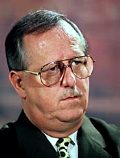|
Week of April 23, 2001 Special Report |
|
A SITE SELECTION ONLINE INSIDER SPECIAL REPORT
What Are You Doing Your Next Four Years? By RON STARNER • Site Selection Magazine Editor  NASHVILLE, Tenn. - Dennis Pawley has made a career out of making people feel uncomfortable with the status quo. NASHVILLE, Tenn. - Dennis Pawley has made a career out of making people feel uncomfortable with the status quo.
Whether it was challenging the conventional way of building cars at Chrysler or creating a learning center for professionals, Pawley says that one key thought has always motivated his leadership style: "If you are not driving change in your organization, you are replaceable." While Pawley's message earlier this month was directed to automotive manufacturers at an industry conference in Nashville, his words could just as easily apply to all corporate real estate executives: Change, he said during the Automotive News New American Manufacturers Conference, or get out of the way and let someone else change your organization. Dennis Pawley in 1995 file photo (Carlos Osorio / Associated Press).
"Leadership can be defined as dealing with change," said Pawley, founder of the Lean Learning Center and former executive vice president and manufacturing for Chrysler, under Lee Iaccoca, in North America. "The cycle of change must always lead from the current reality to the vision in your organization. When the vision becomes the current reality, the cycle repeats." Pawley witnessed this cycle firsthand as a top lieutenant for Iaccoca during Chrysler's turnaround in the 1980s and 1990s. At the pinnacle of his career, Pawley was responsible for more than 80,000 employees and 12 car and truck assembly plants along with five manufacturing technical centers and 18 component stamping and powertrain plants in the United States and Canada. Every organization, he said, is led by one of two cultures - the slow culture or the speed culture. In the slow culture, change is stagnated by a resistance to change and blaming of others when things go wrong. The speed culture, by contrast, thrives because its leaders propel change by modeling it before the employees and by demanding it from everyone in the organization, from top to bottom, said Pawley. "Leadership behavior will always drive the culture," he said. "Culture works to perpetuate itself. The larger the organization, the greater the cultural inertia." How do you know whether you are leading a culture of change or settling for the status quo? Pawley said you can tell by asking yourself the following questions:
"All of our automotive processes must change," said Musser. "We have already reduced product complexity and design cycle times, and we must build to individual order." By the year 2005, she said, GM will make the conversion from manufacturer-to-dealer-network to a "build-to-customer-order" model. Moreover, she said, "GM is committed to engaging the customer and fulfilling customer needs throughout the owner life-cycle." Pawley says he not only welcomes such change among the Big Three Automakers; he thinks it is essential. "In the speed culture, we must ask ourselves: How do we make our products world class or keep them world class?" Leadership that's not willing to deal with change, he said, isn't leadership.
 PLEASE VISIT OUR SPONSOR • CLICK ABOVE PLEASE VISIT OUR SPONSOR • CLICK ABOVE 
©2001 Conway Data, Inc. All rights reserved. Data is from many sources and is not warranted to be accurate or current.
|
